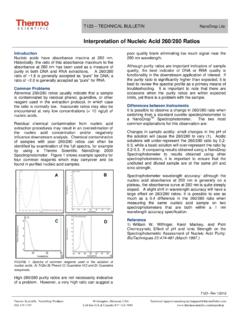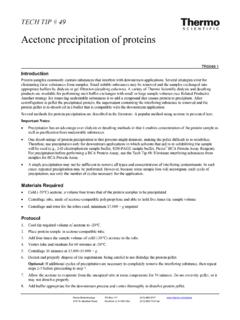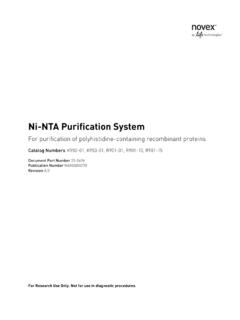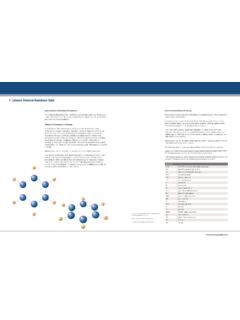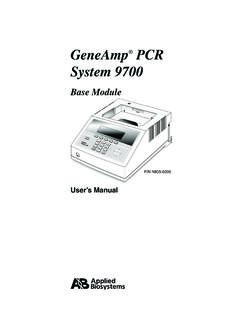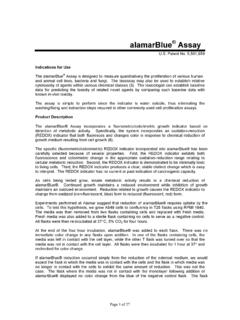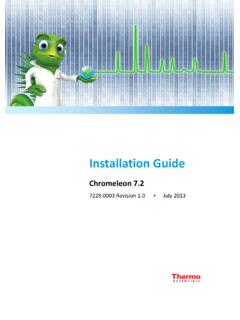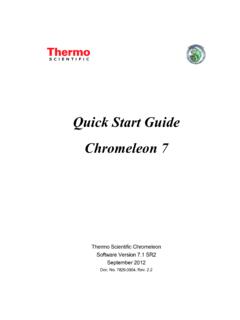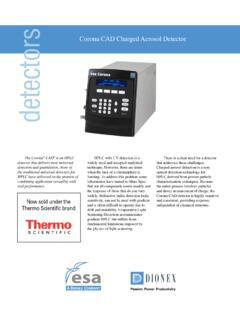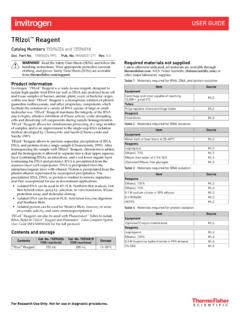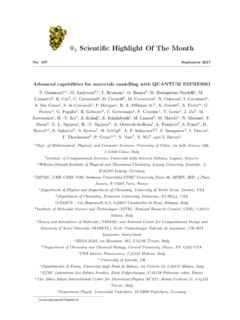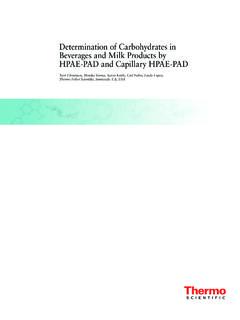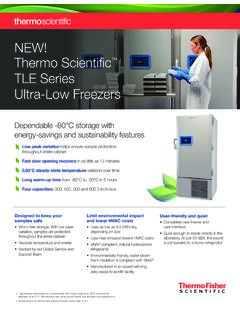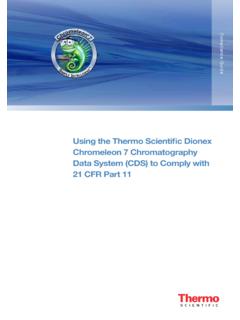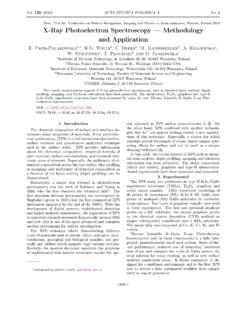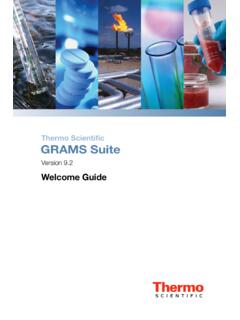Transcription of Thermo Scienti˜ c TSQ Quantiva Triple-Stage Quadrupole ...
1 Product Specifications Extreme quantitative performance through Thermo S c i e n t i fi c Active Ion Management (AIM ) technology Attogram sensitivity Ultrafast selected-reaction monitoring enables quantifi cation of more compounds in less time Robustness and reliability that is unprecedented in a research-grade triple Quadrupole mass spectrometer Close integration with application-specifi c software ensures maximum productivity Simple method development and easy operationThermo scienti c TSQ Quantiva Triple-Stage Quadrupole Mass Spectrometer Extreme quantitative performance with unprecedented easeThe Thermo Scientifi c TSQ Quantiva Triple-Stage Quadrupole mass spectrometer exceeds the most stringent analytical requirements. With AIM technology, the TSQ Quantiva MS achieves unrivaled LODs and LOQs and provides unsurpassed ultra-low-level quantitation of complex and diffi cult-to-run samples. This extreme analytical performance doesn t come at the cost of complexity or lack of durability; breakthrough software and hardware make operation far easier and more reliable than in previous-generation triple quadrupoles.
2 Close integration with application-specifi c software ensures maximum productivity. The TSQ Quantiva MS helps users spend more time thinking about their analyses and less time worrying about instrument setup and SPECTROMETRY2 Hardware FeaturesThermo Scientifi c Ion Max NG API Source Automatic connection of all gases and voltages on installation simplifi es operation and improves reliability Automatic source recognition simplifi es use and data logging Sweep gas reduces chemical noise Enhanced exhaust port effi ciently removes solvent vapor, improving uptime and reducing chemical noise Flexible X, Y, and Z positioning for all ionization probes maximizes performance Optimal 60 degree spray angle Interchangeable HESI and APCI ionization probes Dual-mode HESI and APCI capabilityHigh-Capacity Transfer TubeThe high-capacity transfer tube (HCTT) allows more ions into the vacuum system for improved sensitivity while still providing great Ion Management Ion OpticsAIM technology maximizes ion transmission, eliminates major sources of noise, and precisely isolates analytes to achieve extreme quantitative Ion FunnelThe electrodynamic ion funnel (EDIF) effi ciently captures ions as they leave the transfer tube.
3 Its broad transmission curve reduces ion losses, increasing sensitivity. The EDIF also reduces in-source Beam GuideThe ion beam guide, with its neutral blocker, stops neutrals and high-velocity clusters, keeping the ion optics cleaner, reducing noise, and increasing Quadrupole Mass Filter (Q1 and Q3) Thermo Scientifi c HyperQuad Quadrupole mass fi lters with 6 mm fi eld radius and asymmetric RF drive increase ion transmission and sensitivity. Resolution up to FWHM enables better selected-reaction Collision Cell (Q2)The high-pressure argon-fi lled collision cell produces effi cient fragmentation for high sensitivity. An axial DC fi eld speeds ion transits, yielding up to 500 SRM/s with zero cross Dual-mode discrete-dynode detector increases sensitivity by operating in pulse-counting mode when ion fl ux is low and analog mode when ion fl ux is high Six orders of dynamic range provide high-confi dence quantitationVacuum System Four-stage differentially pumped vacuum manifold Advanced triple-inlet turbomolecular pump integrated with the vacuum manifold Dual rotary vacuum pump confi gurationIntegrated Divert Valve and Syringe PumpFully automated data system control of the divert valve enables switching the solvent front, gradient end point.
4 Or any portion of the HPLC run to Ion Sources Thermo Scientifi c E ASY-Max NG ion source provides high performance with minimal adjustments Thermo Scientifi c E ASY-Spray NG ion source is designed for maximum nanoelectrospray performance with no need for adjustments Thermo Scientifi c Nanospray Flex NG ion source is designed for ultimate nanoelectrospray performance with complete fl exibility of column selectionIon Max NG ion sourceHigh-capacity transfer tube (HCTT)Ion beam guide with neutral blockerHyperQuad Quadrupole mass filterActive collision cell with axial DC fieldsDual-mode discrete-dynode detectorHyperQuad Quadrupole mass filterElectrodynamic ion funnel (EDIF)Figure 1. TSQ Quantiva ion optics3 Software FeaturesData System High-performance PC with Intel microprocessor High-resolution LCD color monitor Microsoft Windows 7 operating system (64 bit) Microsoft Office 2010 softwareStandard MS Software Thermo Scientific Xcalibur processing and instrument control software Tune editor for system calibration, diagnostics, and manual data acquisition Method editor with comprehensive application-specific template library and drag-and-drop user interface to facilitate method development Automated optimization of all instrument parameters, including gas pressures and collision energy, within an experiment Direct control of multiple vendors LC systems and autosampler configurations through Xcalibur software Foundation of shared, state-of-the-art software makes it easier to transfer methods between next-generation instrumentsScan Functions Highly sensitive full-scan MS in Q1 or Q3 Selected-ion monitoring (SIM) in Q1 or Q3 Selected-reaction monitoring (SRM) with up to 30,000 SRMs definable and up to 500 SRMs/s High-resolution ( Da)
5 Selected-reaction monitoring Product ion scanning Precursor ion scanning Neutral-loss scanning Reverse energy ramp MS/MS spectra (RER) gives information-rich MS/MS spectra for solid compound identification Polarity switching capabilities Quantitation-enhanced data-dependent (QED) MS/MS Mixed Mode Scan Function Optional Application-Specific Software Thermo Scientific LCQUAN quantitation software supports 21 CFR Part 11 compliance Thermo Scientific TraceFinder software simplifies method development and routine analysis in food safety, environmental, clinical research, and forensic toxicology laboratories Thermo Scientific Mass Frontier spectral interpretation and classification software for the identification of unknowns Supports the use of Skyline software (MacCoss Lab, University of Washington) for method development and data analysis for peptide applicationsPerformance SpecificationsSensitivityPositive Electrospray (HESI) A 2 L injection of a 500 fg/ L reserpine solution on a Thermo Scientific Hypersil GOLD aQ 20 x mm m particle packed column at a flow rate of 300 L/min 70/30 methanol/water with formic acid will produce a minimum signal-to-noise ratio of 200,000:1 for the transition of the protonated molecule at m/z to the fragment ion at m/z when operated in selected-reaction monitoring (SRM) mode with Q1 and Q3 resolution set to and Da FWHM Pressure Chemical Ionization (APCI)A 2 L loop injection of a 500 fg/ L reserpine solution on a Thermo Scientific Hypersil GOLD aQ 20 x mm M particle packed column at a flow rate of 300 L/min 70:30 methanol/water with formic acid will produce a minimum signal-to-noise ratio of 50,000.
6 1 for the transition of the protonated molecular ion at m/z to the fragment ion at m/z 19 5 .1 when operated in selected reaction monitoring (SRM) mode with Q1 and Q3 resolution both set to Da Electrospray (nESI) A 2 L loop injection of a 500 fg/uL chloramphenicol solution will produce a minimum signal-to-noise ratio of 200,000:1 for the transition of the deprotonated molecular ion at m/z to the fragment ion at m/z when operated in selected reaction monitoring mode (SRM) with Q1 and Q3 resolution set to Da Rangem/z 10 1800 ResolutionQ1 and Q3 adjustable to Da peak width (FWHM) across the entire mass rangeScan Rate15,000 amu/second at a resolution of 2 FWHM500 SRM/second (for any resolution from through FWHM)25msec polarity switchingMass StabilityMass assignment will be within Da over a 24 hour period. The laboratory room temperature must be maintained between 18 27 C (65 81 F). The room temperature may not change by more than 5 C (9 F) during this Includes the divert/inject valve and syringeProduct 2016 Thermo Fisher Scientific Inc.
7 All rights reserved. Intel is a registered trademark of Intel Corporation. Microsoft and Windows are regis-tered trademarks of Microsoft Corporation. Oerlikon is a registered trademark of OC Oerlikon Corporation AG. All other trademarks are the prop-erty of Thermo Fisher Scientific Inc. and its subsidiaries. Specifications, terms and pricing are subject to change. Not all products are available in all countries. Please consult your local sales representative for Research Use Only. Not for use in diagnostic 0716 SAfrica +43 1 333 50 34 0 Australia +61 3 9757 4300 Austria +43 810 282 206 Belgium +32 53 73 42 41 Canada +1 800 530 8447 China 800 810 5118 (free call domestic) 400 650 5118 Denmark +45 70 23 62 60 Europe-Other +43 1 333 50 34 0 Finland +358 9 3291 0200 France +33 1 60 92 48 00 Germany +49 6103 408 1014 India +91 22 6742 9494 Italy +39 02 950 591 Japan +81 45 453 9100 Latin America +1 561 688 8700 Middle East +43 1 333 50 34 0 Netherlands +31 76 579 55 55 New Zealand +64 9 980 6700 Norway +46 8 556 468 00 Russia/CIS +43 1 333 50 34 0 Singapore +65 6289 1190 Spain +34 914 845 965 Sweden +46 8 556 468 00 Switzerland +41 61 716 77 00UK +44 1442 233555 USA +1 800 532 4752 Installation RequirementsPower Three 230 Vac 10%, 50/60 Hz at 16 A minimum Four 120 Vac +6 10%, 50/60 Hz at 20 A or four 230 Vac 10%, 50/60 Hz at 13 A Earth ground hardwired to main panel Free from voltage variations above or below the recommended operating rangeGas Collision gas: pure Argon Collision gas supply pressure: 135 70 kPa (20 10 psig) Sheath/aux/sweep gas.
8 99% pure Nitrogen Sheath/aux/sweep gas supply pressure: 690 140 kPa (100 20 psig) Maximum sheath gas consumption: 20 L/minEnvironment Functional temperature range: 15 27 C (59 81 F) Optimal temperature range: 18 21 C (65 70 F) Heat output: 1550 W (5400 Btu/h) Total system heat output: 4420 W (15,380 Btu/h) Particulate matter: <3,500,000 particles per cubic meter of air (<100,000 particles of >5 m diameter per cubic foot of air) Relative humidity: 20% to 80%, without condensation Floors must be free of vibrationDimensionsSize TSQ Quantiva MS1: 680 760 840 mm (h, w, d 27 30 33 in) Oerlikon SV 65 forepump: 270 320 489 mm (h, w, d 10 13 19 in)Weight TSQ Quantiva MS: 125 kg (275 lb) Oerlikon SV 65 forepump: 52 kg (115 lb)
